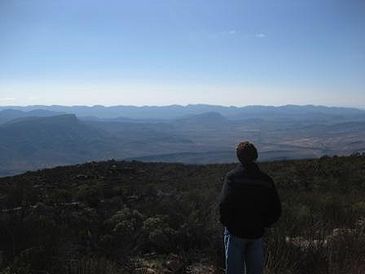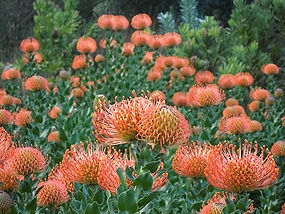Difference between revisions of "Colin Carlson"
(→Current Research: Plasticity, Adaptability and Climate Change (2010-present)) |
|||
| Line 19: | Line 19: | ||
With the help of a CCB Summer Undergraduate Research Award, I traveled to South Africa during the summer of 2010 with the [http://hydrodictyon.eeb.uconn.edu/eebedia/index.php/South_Africa_-_IRES_2010 NSF IRES 2010 group] to measure leaf shape variation in a natural context. For the next year, I studied plasticity experimentally at UConn, examining plastic responses to water stress and shade cues, as well as the associated fitness costs and phylogenetic patterns of this phenotypic flexibility. In many ways, ''Pelargonium'' is an ideal model organism for testing theories of phenotypic plasticity's role in adaptive radiation, given its surprisingly high diversity and the impressive, widespread and diverse nature of plasticity in the genus. | With the help of a CCB Summer Undergraduate Research Award, I traveled to South Africa during the summer of 2010 with the [http://hydrodictyon.eeb.uconn.edu/eebedia/index.php/South_Africa_-_IRES_2010 NSF IRES 2010 group] to measure leaf shape variation in a natural context. For the next year, I studied plasticity experimentally at UConn, examining plastic responses to water stress and shade cues, as well as the associated fitness costs and phylogenetic patterns of this phenotypic flexibility. In many ways, ''Pelargonium'' is an ideal model organism for testing theories of phenotypic plasticity's role in adaptive radiation, given its surprisingly high diversity and the impressive, widespread and diverse nature of plasticity in the genus. | ||
| − | [[Image:red.jpg| | + | [[Image:red.jpg|285px|left]] |
After completing these projects, I entered a new phase in my research, focused on turning our new understanding of the limits and costs of plasticity into valuable information on species vulnerability to climate change. The project focused in particular on evaluating the vulnerability of ''P. elongatum'', a species that is currently classified as Least Concern in South Africa, and that has displayed tremendous plasticity in both natural and experimental settings. Using ''P. elongatum'' as a "testing ground" for a novel set of spatially-discrete models that include the costs of plasticity into otherwise entirely climate-driven ecological niche models, with the goal of understanding the consequences of potentially-costly plasticity for population survival. | After completing these projects, I entered a new phase in my research, focused on turning our new understanding of the limits and costs of plasticity into valuable information on species vulnerability to climate change. The project focused in particular on evaluating the vulnerability of ''P. elongatum'', a species that is currently classified as Least Concern in South Africa, and that has displayed tremendous plasticity in both natural and experimental settings. Using ''P. elongatum'' as a "testing ground" for a novel set of spatially-discrete models that include the costs of plasticity into otherwise entirely climate-driven ecological niche models, with the goal of understanding the consequences of potentially-costly plasticity for population survival. | ||
| − | + | ||
| + | |||
Thus far, these models have suggested that the future of ''P. elongatum'' is strongly dependent on demographic conditions, and while the species may indeed be low priority for conservation, a very small range of variation in seed and adult survivorship could even have the ability to drive the species to extinction in the next ten years. (More about these findings will be presented this April at Frontiers in Undergraduate Research and the results of the models are also currently being prepared for publication.) Ultimately, it is my hope that this project will take a crucial first step towards applying theoretical models of plasticity and extinction risk to actual high-diversity, high-plasticity, high-risk taxa. | Thus far, these models have suggested that the future of ''P. elongatum'' is strongly dependent on demographic conditions, and while the species may indeed be low priority for conservation, a very small range of variation in seed and adult survivorship could even have the ability to drive the species to extinction in the next ten years. (More about these findings will be presented this April at Frontiers in Undergraduate Research and the results of the models are also currently being prepared for publication.) Ultimately, it is my hope that this project will take a crucial first step towards applying theoretical models of plasticity and extinction risk to actual high-diversity, high-plasticity, high-risk taxa. | ||
| − | + | ||
==Other research projects== | ==Other research projects== | ||
====Snapping Turtle Research (2008-2010)==== | ====Snapping Turtle Research (2008-2010)==== | ||
Revision as of 18:26, 7 April 2012
I am an eighth semester University Scholar in EEB, with an additional major in Environmental Studies. I'm currently studying plasticity in the genus Pelargonium, for which I was awarded a 2011 Goldwater Scholarship. I was also named a 2010 Udall Scholar and a 2011 Truman Scholar for my environmental work on and off campus.
Contents
Research Interests
Functional and evolutionary ecology; plant conservation and climate change; ecological modelling.
Current research: plasticity and climate change (2010-present)
"All is leaf, and through this simplicity the greatest multiplicity is possible." - Johann Wolfgang von Goethe
My current research began as a simple project focusing on light-induced leaf shape dimorphism in South African Pelargonium L’Her (Geraniaceae). The focus of this research can be condensed into the following three questions:
1. For what traits, in what species, is leaf shape plastic? (The "what?")
2. Does selection appear to act on plasticity itself, and at what spatial/phylogenetic levels? (The "why?")
3. Have leaf traits evolved independently in their plasticity, and is there any suggestion of evolutionary/environmental constraints on these traits and/or their plasticity? (The "how?")
With the help of a CCB Summer Undergraduate Research Award, I traveled to South Africa during the summer of 2010 with the NSF IRES 2010 group to measure leaf shape variation in a natural context. For the next year, I studied plasticity experimentally at UConn, examining plastic responses to water stress and shade cues, as well as the associated fitness costs and phylogenetic patterns of this phenotypic flexibility. In many ways, Pelargonium is an ideal model organism for testing theories of phenotypic plasticity's role in adaptive radiation, given its surprisingly high diversity and the impressive, widespread and diverse nature of plasticity in the genus.
After completing these projects, I entered a new phase in my research, focused on turning our new understanding of the limits and costs of plasticity into valuable information on species vulnerability to climate change. The project focused in particular on evaluating the vulnerability of P. elongatum, a species that is currently classified as Least Concern in South Africa, and that has displayed tremendous plasticity in both natural and experimental settings. Using P. elongatum as a "testing ground" for a novel set of spatially-discrete models that include the costs of plasticity into otherwise entirely climate-driven ecological niche models, with the goal of understanding the consequences of potentially-costly plasticity for population survival.
Thus far, these models have suggested that the future of P. elongatum is strongly dependent on demographic conditions, and while the species may indeed be low priority for conservation, a very small range of variation in seed and adult survivorship could even have the ability to drive the species to extinction in the next ten years. (More about these findings will be presented this April at Frontiers in Undergraduate Research and the results of the models are also currently being prepared for publication.) Ultimately, it is my hope that this project will take a crucial first step towards applying theoretical models of plasticity and extinction risk to actual high-diversity, high-plasticity, high-risk taxa.
Other research projects
Snapping Turtle Research (2008-2010)
This project analyzed the behavior of three Snapping Turtles (Chelydra serpentina) along the Connecticut river. The footage, collected over the summer, was from the turtles Jawless and Lafayette from Wethersfield Cove, and Snippy from Shenipsit Lake. (see the snapping turtle research team page for the full story on the turtles). Also, for more information on Crittercam itself, visit National Geographic's Crittercam Homepage. This analysis encompassed the breath, dive, pausing, walking, and other aspects of locomotion of the three turtles. If you would like to read more about the actual data analysis, check out Snapping Turtle Research: Analyses and Conclusions.
My research on this project was divided into two main stages. First came an analysis of the duration and frequency of breathing and diving behaviors, which revealed a strong positive relationship between breath and dive duration. Second, I described behavioral patterns in the turtles through an analysis of locomotion that was divided into five sub-categories, and I found strong differences between average limb frequency cycles.
Sacred Groves and Community-based Conservation (2010-present)
As sacred groves are one of the most ancient forms of community-based conservation, my Environmental Studies senior thesis seeks to understand a number of questions about their function and distribution, with a particular focus on tracing the origins of tree worship on a global scale. By using comparative linguistics, ethnographic records and archeobotany, I have attempted to trace these origins as far back as they go, to approximately 10,000-15,000 BP. Ultimately, my goal is to understand why groves are so stable - and how this stability can be achieved by secular conservation institutions. Moreover, as globalization eradicates local tradition and culture in many places, the socio-religious foundation that supports maintenance of sacred groves is becoming precarious. In order to ensure the ecological integrity and cultural heritage embodied in sacred groves, it is necessary to consider the social, political and environmental factors that influence the formation, preservation and potential destruction of sacred groves and the belief systems that maintain them.
Conservation Philosophy and Career Aspirations
"I know the human being and fish can coexist peacefully." - George W. Bush
One of the major problems that faces conservation and environmental advocacy is that advocates don't always understand science, and environmental biologists aren't always skilled advocates (no offense, guys!). This gap between activism and science is one that I have found to be a major obstacle in my environmental work as director of the Cool Coventry Club and as a steering comittee member of the Connecticut Youth Activist Network, and it is one that has shaped my career goals profoundly. More about me: I'm part of the EcoHouse living community on campus (and will continue to be next year), a member of environmental organizations such as EcoHusky, and this October I was the chief organizer of the first-ever UConn Environmental Justice Forum, funded by the Human Rights Institute. After I graduate from UConn, I plan to go to graduate school to receive my Ph.D., and ultimately hope to stay in academia, conducting research with conservation-relevant implications.
Publications
Landberg, T., Carlson, C. J., Abernathy, K., Luginbuhl, C., Gemme, P. and Mergins, C. (2010) Natural History Notes: CHELYDRA SERPENTINA SERPENTINA L. (Eastern Snapping Turtle). SURVIVAL AFTER INJURY. Herpetological Review 41(1):70-71. ![]()
Poster Presentations
Carlson, C.J. and C.D. Schlichting. (2011) Dimensionality and Diversification: “Shedding Light” on Natural Phenotypic Plasticity in Pelargonium (Geraniaceae). UConn Frontiers in Undergraduate Research Poster Exhibition. April 15, 2011.
Carlson, C.J., C.D. Schlichting, and A.M. Wilson. (2012) Phenotypic plasticity and extinction risk in South African plants: a reaction norm approach to ecological modeling. UConn Frontiers in Undergraduate Research Poster Exhibition. April 13-14, 2012. ![]()
Other Presentations
April 26, 2012. "The cultural evolution of sacred groves: seeing the forest for the trees." Sponsored by UConn Department of Anthropology.
Questions or comments about this page or its twin (Snapping Turtle Research: Analyses and Conclusions) can be sent to Colin.Carlson@UConn.edu


